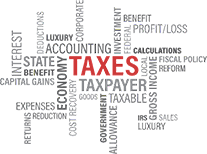Tax Acts of 2019

On December 20, 2019, “The Further Consolidated Appropriations Act” was signed into law, providing government funding and including various tax provisions. Included in the tax provisions were retirement plan funding and distribution reform, known as the “SECURE Act of 2019” as well as extenders, disaster relief and miscellaneous items, known as the “Taxpayer Certainty and Disaster Tax Relief Act of 2019”.
THE SECURE ACT of 2019
The SECURE Act of 2019, “Setting Every Community Up for Retirement Enhancement” Act, introduced the most sweeping changes to retirement legislation since the Pension Protection Act of 2006.
Starting in 2020, changes relating to IRAs include:
- Required minimum distributions (RMDs) must start at age 72 rather than at 70-1/2. This applies to individuals who have not reached age 70-1/2 as of December 31, 2019.
- Individuals may contribute to their IRAs as long as they continue to work after 2019.
- Non-spouse inherited IRAs require that distributions be taken within ten years, eliminating the “stretch IRA”, in which distributions could be taken over the beneficiaries’ lifetime. There are exceptions for spouses, disabled individuals, those not more than ten years younger than the account owner, and minor children (until they reach the age of majority). The ten year rule also applies to non-spouse inherited ROTH IRAs. [Be sure to review all beneficiary details and trust documents in this regard.]
- Taxable non-tuition fellowships and stipends as well as nontaxable “difficulty of care payments” by home healthcare workers can be treated as compensation for IRA purposes.
Changes beginning in 2020 relating to 401-Ks include:
- New parents can take penalty-free distributions up to $5,000 per parent per child from a qualified retirement plan (including IRAs) within a year after a birth or finalized adoption
- The tax credit for small employers for start-up costs of new pension plans increased from $500 to a $5000 maximum.
- Small employers can receive an additional $500 tax credit for auto-enrollment plans.
- The auto-enrollment safe harbor cap increased from 10% to 15% of wages.
- Employers are required to offer 401(k) participation to qualified long-term, parttime employees after 2020. Such employees must work either 1,000 hours during the year or have three consecutive years with 500 hours per year.
- Unrelated employers can participate in pooled multiple-employer plans (MEPs).
- Employers are encouraged to include more annuities to be offered within 401(k) plans.
- Retirement plan loans accessed through credit cards will be deemed taxable distributions.
Other changes included:
- Although qualified charitable distributions up to $100,000 per year can still be made from your IRAs beginning at age 70-1/2, it is possible to do so even if you are not taking RMDs, effective in 2020. An anti-abuse rule may limit how much can be taken as taxfree QCD, however, requiring any remainder to be used only as a charitable contribution.
- Over a beneficiary’s lifetime a maximum of $10,000 can be taken from a 529 plan to pay qualified student loan repayments for the plan’s beneficiary or their sibling, starting 2020.
- Another change is that 529 plans can be used for higher education expenses for DOL registered and certified apprenticeship programs, retroactive to 2019.
TAXPAYER CERTAINTY AND DISASTER TAX RELIEF ACT OF 2019
EXTENDERS:
Over 30 previously expired or expiring tax extenders were made retroactive to 2018 and extended through 2020. Among the individual extenders reinstated were:
- Reducing the AGI floor for medical expense deductions from 10% to 7.5%
- Reinstating the deduction for tuition and fees expenses
- Allowing private mortgage insurance premiums (PMI) as deductible interest expense
- Excluding from income of qualified residence indebtedness
Included in the business extenders were:
- Certain depreciation and expensing relating to racehorses, motorsports entertainment complexes, Indian property, film and television productions, and energy efficient commercial buildings deduction
- Energy-efficient homes credit for contractors and manufacturers
- Credits for nonbusiness energy property, qualified fuel cell vehicles, alternative fuels, energy-efficient commercial buildings, and biodiesel and renewable diesel fuel
- Other industry or group specific credits relating to railroads, mines, Indians, and American Samoa
- Expiring provisions including New Markets tax credit, Work Opportunity tax credit, paid family and medical leave credit for employers, controlled foreign corporations look-thru rule and craft beverage provisions.
DISASTER RELIEF:
Disaster relief included an employee retention credit for employers and tax-favorable withdrawals from retirement funds. It also set special rules for disaster-related personal casualty losses and calculating the earned income tax credit. It relates to all declared disasters from January 1, 2018, through 30 days after the date of enactment.
MISCELLANEOUS ITEMS:
- Certain ACA health care provisions were repealed, namely the medical device excise tax and the excise tax on high cost employer-sponsored health coverage (known as the “Cadillac tax”) both effective 1/1/2020, as well as the annual fee on health insurance providers effective 1/1/2021.
- Modified were the TCJA rules pertaining to the taxation of children’s unearned income, to again be taxed at the parents’ rate rather than at the trust and estates rate.
- Repealed was the TCJA modification to unrelated business taxable income of tax-exempt organizations (known as the “church parking tax”).
- The penalty for failure to file tax returns increased to $400 (or amount of tax due).
In addition, if you are the owner of an existing small business or are thinking about starting a small business, Judy can advise you on the best business structure for your needs. Call (603) 432-0310 today to set up an appointment.